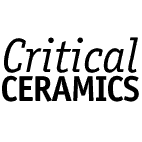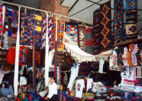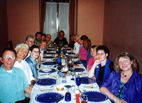



Templo de Dos Columnas

Eric Mindling

A mercado

Alberta Mateo Cruz

Candling the pottery
Paula Sibrack Marian
This is the sixth time that David Furman, art professor at Pitzer College, Claremont, CA has enticed a group of NCECA conferencees to leave home days early and become turistas in Mexico. An old hand at Latin American travel, David has a knack for finding authentic, non-touristy hotels, reasonable air fares, and locations that ceramic artists can’t help but respond to.
The origin of the MexTrips started when David was an NCECA Director-at-Large in 1986. “During that epoch, [Directors] were given freedom to ‘create a reason’ for their position on the Board, and I chose to instigate a trip to Mexico City”, explained Furman.
David chose Mexico as a destination because “I love the ambiance, the laissez faire attitude, and ...the distinctive rhythm of life that exists south of our border. I’ve probably spent four years of my life living in Mexico, Central and South America. I’m continually astonished by the diversity of culture, pre-Colombian and contemporary, and the many artful manifestations.”
“It is fun and exciting, and challenging (and not without an occasional headache) to put these adventures together. And it gives me great pleasure to act as a catalyst/provocateur for people interested in discovering the diversity that exists in Mexico”, David continued.
The state of Oaxaca is 250 km south of Mexico City, separated by high mountains, which help to retain its remoteness. There are many Indians — Zapotec, Mixtec, Ayu'uk, Nahuatl speaking 15 languages and many more dialects — still living and producing handcrafts in Oaxaca. The city has quaint stone colonial buildings, a beautiful central plaza, and many markets for both local produce and hand crafts.
An outstanding landmark is Museo Rufino Tamayo. The building was donated by its namesake. It houses none of Tamayo’s own art, but instead his spectacular collection of pre-Hispanic artifacts, which he wished to protect within the borders of Oaxaca.
Many in our group traveled outside the city to explore Monte Alban, the ancient hill top Zapotec capital. Temples, residences, a ball court and pyramids are preserved along with a museum of artifacts.
In Teotilan del Valle, we visited a haven for weaving. Seemingly everyone in this village has something to do with weaving and it has been that way since pre-Hispanic times. From the shepherds herding sheep outside of the town to the vendors who are selling their own blankets at the Mercada de Artesanas, all are tied up in this home industry.
Central to the success of this year’s trip, was an ex-potter Eric Mindling who, with his illustrator wife and young daughter, has made his home in Oaxaca for eight years. Our group was invited to Eric’s home and warehouse/show room. He wholesales pottery to dealers in the US. We were amazed at how many different styles exist of Oaxacan pottery — red pots, splattered pots and black pots, in both old and new styles. Eric has written an excellent article, Finding Oaxaca (Ceramic Monthly, February, 2000), that details the regional pottery tradition that dates back some 4000 years!
On an outing Eric, escorted a group of us to the East Valley village of San Marcos. We had the privilege of spending an afternoon with Zapotec potter Alberta Mateo Cruz and her family. We watched Alberta construct several pots with coils on a primitive banding wheel. These pots were quickly, expertly, and artfully done. Later, Alberta proceded with a bonfire firing, which took only about a hour. When the pots were not quite cool, we quickly bought most of them.
Seeing so much authentic Mexican folk pottery together with so many other potters provided us with a submersion and constant conversation of this simple, direct, mostly anonymous art form. Very few Oaxacan village potters sign their work. There is no fancy equipment used in the process. Most potters work to make a living, as generations of people in their family have done before them. This Mexican pottery is not done to make an art statement. I asked the members of our group what impact this trip, and the vast amount of regional pottery that we saw, would have on their life and their work.
Harriet Brisson, professor emeritus in ceramics at Rhode Island College, has been on many MexTrips. She is interested in bringing home information on primitive firing and comparative primitive pottery. For example, she makes connections between pottery in Mexico and what she has seen in Europe, Asia and South America. Harriet is fascinated by the connections between these primitive cultures and their art work. When asked if her own work would change as a result of this trip, Harriet said she hoped so. “My work has always been highly structured. Primitive firing is one way to combine chance patterns with the geometric form basis of my work. I want the mark of the firing to complete my pieces. I use different fuels to produce unique qualities that finish the pieces. ”
Richard Buncamper, professor of ceramics at Kean University, Union, NJ, has visited Mexico several times and studied in Oaxaca at the Instituto Cultural. Seeing this artwork is for him is a “reaffirmation of simplicity...[American pottery] tends to get so complicated and embellished with so much stuff, including our egos and technique. But in Oaxaca the work is so close to the people, so very direct.” For Richard, coming to Mexico has made his own art work more direct and personal.
Harris Deller, professor of ceramics at Southern Illinois University School of Art, had been to Mexico before but this was his first time traveling with the MexTrip group. Harris thought that the most remarkable image he saw was Monte Alban. “The way another culture was influenced by the landscape, I found very inspiring. I was ... moved by the pyramids and their deterioration, and how they set up along the horizon line and create a positive/negative space.” Another strong influence was the geometric patterning of the pyramids and how parts had worn away.
John DiCicco, ceramics professor at Providence College, RI has been on many MexTrips. Oaxaca was the most important trip for him because of the opportunity to view first hand the amazing skill and grace of pots being made. The technique that Alberta Mateo Cruz demonstrated will stay with him always. “[our school’s] clay body wouldn’t stretch like the one at San Marcos, but I’d like to expose my students to a similar technique of hand building..” John would also like to emulate the high survival rate of bonfire firing we witnessed.
David Furman says that the pots of Oaxaca have inspired him, although not directly in his own work. “I’m a honky from L.A. living on the cusp of the 21st century. I’m a victim of my own time... Art that is provocative and good [for me] is art that is reflective of the time and space in which it was produced.” By seeing the art work of other cultures and other periods, David feels, it strengthens the connections to his own work, his love of others cultures, love of indigenous materials in context, and “it inspires me to keep on my own path”.
Linda Lighton, Kansas City clay artist and teacher, has been on many MexTrips. She is very involved with color in her work, so Linda especially enjoyed the joyful display and range of colors — in the spirited carved wooden figures and the Indian clothing. “There’s a paint store in Oaxaca that carries 354 shades of blue” Linda shared with me. She “loves the heartfelt sincerity of the Mexican people, the naiveté, and the lack of guile” which she hopes is apparent in her own work.
Terry Lyon, Davis, CA, is on the ceramics staff for the Mendicino Arts Center. What Terry finds most interesting about all of these MexTrips is the distinct native cultures.“Their approach to enclosing space or volume is remarkably different than what I grew up... with my wheel.” This gives him a different perspective — to see pottery through another culture’s eyes and appreciate a new approach. Although it hasn’t changed the way he works, he has introduced tripods to his pieces. “Simplicity without being simplistic” could be his motto.
Linda McNary, Minneapolis, MN is a graphic artist and ceramics instructor. “My life is my art. I incorporate whatever happens to me into my art.” Linda is interested in both primitive firing techniques and functional pottery. Those two qualities rarely unite in the US. She was excited to see functional ware being fired in a primitive way. Linda may try this combination — functional and primitive — at home.
Cheryl Tall, Stuart, FL is a clay sculptor who works with architecture and the figure. She goes on many trips which influence her art work. Pieces of architecture that she has seen during her travels often show up in her work.“ I’m sure the rough stucco texture and the color of the filled-in doorway across from our hotel will find its way into my work.” Cheryl and I spoke about the inside/outside concept of Mexican architecture: plain outside walls, with a hidden wealth of details and lush garden inside. That concept — inside/outside — could now be a strong influence on her sculpture .
Lucy Yogerst, Minneapolis, MN has been wanting to visit Oaxaca since its name appeared as a vocabulary word in her fourth grade Spanish lesson. Lucy is on the faculty of Northern Clay Center and, after five Mexican art trips, is enamored with Mexican life and art. She rejoices in the wealth of color, shapes and texture in Mexico, not only in the pottery, but in the architecture.
Eric Mindling, a former potter, left northern California eight years ago on a quest to find authentic Mexican potters and has been working in Oaxaca ever since. Eric runs his business, writes about his experiences (on Clayart and on his web page) and plans to make a video. He enjoys knowing about each potter’s family and the slower pace of doing business.
Each year, Eric offers approximately six workshops with six to eight participants. They are introduced to Oaxacan potters and the slow pace of Mexican living. The workshops includes digging clay, making pots and primitive firing. Contact Eric by email for more information.
Paula Sibrack Marian has been a potter for over 30 years, lived in Mexico and Latin American, and studied textiles in Bogota, Colombia. Paula has found that through her interest and travel to Mexico, she has continued to be committed to color, pattern and texture in her clay work. Currently, she is Head of the Art Department at New Milford High School, CT. In addition, she is a member of Connecticut Clay Artists. Paula is an active participant in NCECA and has written many articles for the NCECA Journal. Paula enjoys the listserv Clayart, riding through cyberspace and is thrilled to be a contributor to Critical Ceramics.

Fueling the fire

The firing

Unloading

Fired pottery

The MexTrip Group